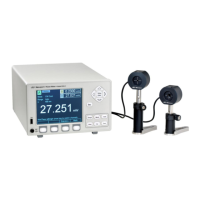System Operation 51
4.2.1.6 Mode Selection
This setting allows the user to change the measurement mode. The available
modes are as follows:
Continuous Wave Continuous Run (CW Cont.)
Continuous Wave Single Shot (CW Single)
Continuous Wave Integral (CW Integ.)
Peak-to-Peak Continuous Run (Pk-Pk Cont.)
Peak-to-Peak Single Shot (Pk-Pk Single)
Pulse Mode Continuous Run (Pulse Cont.)
Pulse Mode Single Shot (Pulse Single)
RMS Measurements (RMS)
Refer to Section 5, Performing Basic Measurements, for detailed information
regarding these modes.
4.2.1.7 Spot Size
This setting allows users to change the spot size. The default spot size is set
to be same as the detector size. The spot size can be modified by navigating
the cursor to this setting, and pressing the Setup/Enter key. The value then
becomes editable; each digit in the value can be changed by pressing
Up/Down arrow keys, and different digits can be selected by pressing
Left/Right arrow keys. The desired value can be accepted by pressing
Setup/Enter key.
4.2.1.8 Number of Digits Setting
The 1936/2936 Series displays a default 4 number of digits. To change these
settings bring the cursor on top of the Num. Digits field. Hit the Enter key. A
drop-down menu appears with the option of 3, 4 or 5 digits. Select the desired
number of digits and hit Enter.
4.2.1.9 Offset Field
On the right column of the Measurement Settings the unit displays the Offset
stored when the user hit the Zero dedicated key. This value can be cleared or
updated if the unit is in the default screen and Zero is pressed (see Section
4.1.6 for more information).
4.2.2 Detector Information
The Measurement Settings screen displays information about the detector
used based on the data available in the detector calibration module or detector
internal memory.
The available data are the detector model number (Detector), the detector
serial number (S/N), the detector temperature (Det. temp.) if the detector has
an internal temperature sensor, and the detector responsivity (Responsivity).

